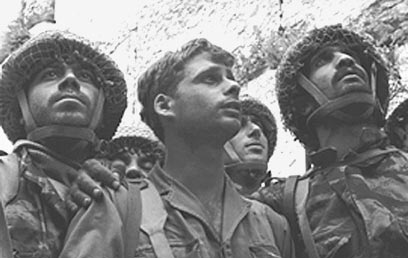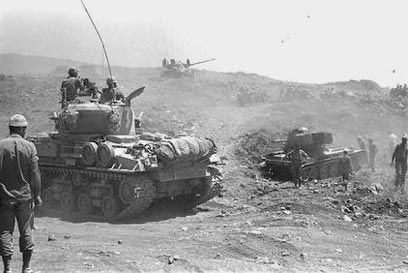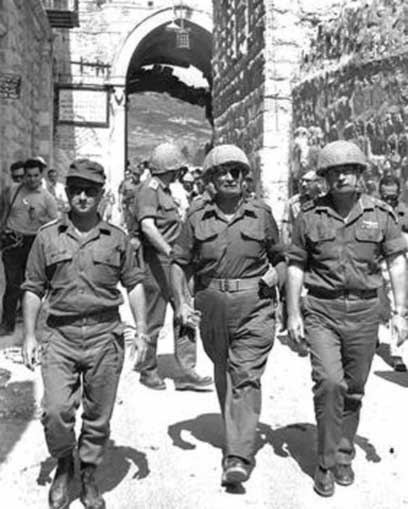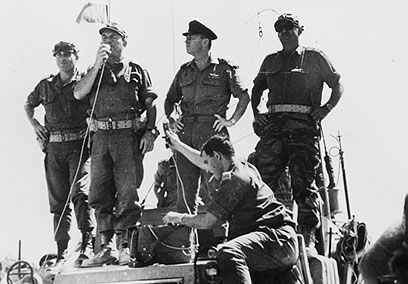

The Six Day War (5-10 June, 1967) erupted between Israel, Egypt, Jordan and Syria due to an escalation in Israeli-Arab tensions, the state of inter-Arab relations, and world powers' intervention in Middle East affairs.
A number of factors fueled Israeli-Arab tensions at the time: First and foremost was the Arab League's decision to divert the sources of the Jordan River away from the Sea of Galilee (Lake Kinneret) into Syrian and Lebanese territory, combined with Israel national water carrier becoming operational in 1964. The standoff over regional water sources is considered the prime catalyst for the war.
Second came the Arab League's decision to name the PLO (Palestine Liberation Organization) as the Palestinian's official body. That, complied by a series of Syrian-sponsored terror attacks in Israel, caused regional tensions to soar.
Syria was believed to be trying to strengthen its position in the Arab world and challenge Egypt's dominance, after its 1961 decision to quit the United Arab Republic – the joint state it had formed with Egypt three years earlier as a first step to establishing a pan-Arab nation.
According to various analysts, news of Israel's nuclear reactor in Dimona spurred panic in Egypt, further aggravating the situation.
War's prelim
On April 7, 1967 six Syrian MiG-21 fighter jets were shot down by the Israeli Air Force in what was initially a minor border confrontation, prompting Syria turned to Egypt requesting urgent assistance. Meanwhile, on May 13, the USSR falsely informed Egypt that the IDF had deployed a large force along the Syrian-Israeli border. Then-Egyptian President Gamal Abdel Nasser answered Syria's plea and dispatched seven military divisions to its border with Israel and sending nearly 1,000 Egyptian tanks to Sinai.
Paratroopers at the Western Wall (Archives: GPO)
The Egyptian troops met the United Nations Emergency Force, deployed along the Israeli-Egyptian border. Cairo asked the UN to evacuate its forces from the border but then-UN secretary-general, Myanmar's U Thant, refused, saying the forces would either remain in place or would withdraw completely.
On May 17, Nasser informed Thant that he should evacuate all UN troops from Sinai and the Gaza Strip. The order were immediately executed, prompting a near immediate deployment of Jordanian troops Amman's border with Israel.
Israeli intelligence indicated that Egypt was not interested in an armed confrontation, since its forces were involved in the civil war in Yemen. On May 20, however, Egypt began withdrawing its troops from Yemen, prompting Israel reassess the situation and subsequently order a wide mobilization of reserve forces, which nearly paralyzed Israel's economy.
May 22, 1967 saw Egypt close the Straits of Tiran to Israeli ships, a belligerent move which Israel regarded as direct provocation Egyptian President Nasser was later quoted as declaring "if IDF Chief of Staff Yitzhak Rabin wants war, then he was welcome to it."
On May 30, Jordan informed Egypt its troops were at Cairo's disposal, as Iraq and several other Arab nations followed suit. Israel's plea to the western powers and the UN to intervene in order to prevent a war were left unmet.
June 2, 1967 welcomed a new government in Israel. The new cabinet named Israel's fourth Chief of Staff Moshe Dayan its defense minister. The following day, France – Israel's chief weapons supplier – declared a weapons embargo in the Middle East.
War breaks out
On June 4, Israel decided to launch a preemptive strike against neighboring Arab air-force bases in order to assume airspace control on the region.
On the morning of June 5, 1967, the Israeli Air Force pummeled Egyptian, Syrian and Jordanian airfields, destroying over 350 planes within a few hours. Only 20 Israeli jets were shot down during the fighting, mostly by anti-aircraft missiles. IAF fighter jets also made sure any existing runways were demolished, so as to paralyze the remaining enemy warplanes.

Israeli tanks at the Golan Heights (Archives: GPO)
Egypt's airfields were targeted first, followed by those in Syria and Jordan. An Iraqi airfield on the Jordanian border was also bombed. Special significance was placed on disabling the Egyptian airfields in the Nile Delta, which housed warplanes equipped with long-range missile systems, capable of hitting civilian targets in Israel.
The aerial assaults on Egypt, Syria and Jordan, dubbed Operation Focus, were over within a matter of hours, enabling the IDF to focus on enemy ground forces, which were targeting traffic routes. More enemy airfields were targeted on the second day of fighting, and by the time the war ended, 451 enemy planes were destroyed, as opposed to 46 IAF planes. The success of Operation Focus almost entirely prevented the targeting of civilian Israeli sites from the air.
Many Israeli communities however, suffered artillery attacks, as the Jewish parts of Jerusalem, periphery towns and kibbutzim on both the Gaza perimeter and under the Golan Heights were found themselves under fire. On the northern border, the Syrian attacks continued for three straight days, and residents' pressure on the Israeli government played an important role in the decision to capture the Golan Heights, a move Dayan initially opposed.
The Egyptian front
In Sinai, the Egyptians amassed about 1,000 tanks and 100,000 soldiers – four infantry divisions in the front plus another infantry division and a tank regiment further from the border. Another armored division was held in reserve further inland.
The IDF's ground forces entered Sinai in three arrays: Major-General Israel Tal's division advanced through Gaza and El-Arish; while Maj.-Gen. Avraham Yoffe's central division and Maj.-Gen. Ariel Sharon's southern division entered the heavily defended Abu-Ageila-Kusseima region.
On the eve of the first day of fighting, after intense battles, Tal's forces reached El-Arish and Sharon's division prevailed in the most important encounter in north Sinai in the Battle of Abu-Ageila. Meanwhile Yoffe's division advanced on the Egyptian defenses and captured the Bir Lahfan junction. By the end of the first day, part of Tal's division headed north to the Gaza Strip. By July 7, the IDF captured Gaza City.
The three divisions continued to apply heavy pressure on the Egyptian forces and by the fourth day Israeli forces reached the Suez Canal. Paratroopers landed in Sharm el-Sheik, while naval forces took control of the Straits of Tiran. By June 8, the IDF held the entire Sinai Peninsula and most of the Gaza Strip.

Moshe Dayan (M), Chief of Staff Rabin (R) walking through the Old City's Lion's Gate (Archives: GPO)
The Jordanian front
Jordan lost all its entire air force during the first day of fighting, but still had a large, well-trained ground force at its disposal. The Jordanian army included 60,000 soldiers and 300 tanks, and was backed by an Egyptian commando division.
Despite an Israeli warning to the contrary, Jordanian troops mounted an attack on Tel Aviv on June 5, 1967 and took the Government House in Jerusalem's Hill of Evil Counsel. Artillery attacks were also launched on West Jerusalem and communities in the Sharon Region and the Jezreel Valley. The IDF received authorization to take over the West Bank.
The Jerusalem Brigade forced the Jordanians out of the Government House, occupied its surroundings, and continued toward Bethlehem. The Armor Corps' Harel Brigade breached Jordanian military lines north of Jerusalem and took Radar Hill overlooking the Tel Aviv-Jerusalem Highway. At the same time, a Northern Command division stormed West Bank, heading for Jenin.
On June 6 the Kiryati Brigade stormed – and took – the Latrun Fortress, later liaising with IDF armored forces west of Ramallah. The Paratroop Brigade breached Jordan's lines north of Jerusalem, and after a tough battle at Ammunition Hill, reached Mount Scopus and rejoined it with the city of Jerusalem.
Forces operating in the Sharon Region conquered the West Bank city of Qalqilya, while a Northern Command division was engaged in a difficult battle with Jordanian troops in the Dotan Valley, near Jenin, before eventually taking over the city and nearby territories.
On June 7, the Jerusalem and Paratroop brigades, commanded by Mordechai Gur, took control of the Old City of Jerusalem. After extremely heavy fighting, the troops burst through the city's Lion's Gate and captured the Western Wall and Temple Mount.
The Jerusalem Brigade then stormed through the Old City's Dung Gate, opening a clear path through the southern parts of east Jerusalem, before continuing south and capturing Bethlehem, Hebron and Gush Etzion. The Northern Command division seized Nablus. The forces continued moving along different lines towards the Jordan Valley, where they pushed the remaining Jordanian forces east of the river and detonated the river's bridges. IDF forces were under strict order not to cross the river.
The Syrian Front
The IDF was able to avoid any ground operation against Syria during the first days of fighting, so as not to divide its troops along three different fronts. The Syrian Air Force was destroyed during Operation Focus and a Syrian attempt to capture the water plant at Tel Dan was thwarted. Nonetheless, the Syrian front was subject to heavy fire exchange for the next three days.

Photo courtesy of the Rabin Center
The Syrian army, consisting of 75,000 troops, dominated the strategic Golan Heights. The Israeli forces on this front consisted of one division and a few brigades. The IAF was ordered to strike Syrian positions with guns blazing and the Syrian front line, overlooking the Golan plateau, was severely hit.
By the end of June 9, Israeli forces had taken most of Syrian front line. June 10 saw the Syrians forces pushed 18 miles back, as IDF forces and took control over the lower area of the Hermon slope, Hamat Gader and the whole Sea of Galilee.
War's end, aftermath
The Six Day War saw the military advantage held by Israel's neighboring Arab countries annihilated as hundreds of tanks were destroyed, over 15,000 enemy soldiers were killed or wounded and some 6,000 were taken prisoner.
The IDF suffered 777 fatalities and over 2,500 casualties. Israel won valuable territory, the Syrian threat no longer loomed over the communities adjacent to the northern border and Jerusalem was reunited. Within a few days Israel officially announced the annexation of east Jerusalem, and stated that the city was to be its eternal capital.














